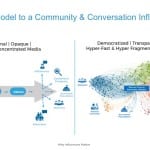YouTube is once again in hot water for running ads on channels promoting disturbing content, a CNN investigation has uncovered. More than 300 organizations had their ads running on channels promoting Nazis and North Korean propaganda, to name two. For now, brands are still willing to take the risk.
Latest Posts


Snapchat Ties Bottom Line to Ad Spend With Shoppable Lenses
April 19th, 2018 by Sophie MaerowitzSnapchat has announced a new feature, Shoppable Lenses, that aims to win brands’ advertising dollars by trading “soft” metrics like opens and impressions for clickthroughs, conversions and calls to action that can be tied directly to sales. The feature, which uses Snapchat’s AR lenses and allows users to virtually try a new product, could be a game changer for B2C brands, while acting as a proof-of-concept for companies wary of the platform.

2018: The Year the Community and Conversation Influencer Model Got Real
April 19th, 2018 by Steve GoldsteinBringing together people who share common concerns and interests while putting a brand’s immediate needs in the background—or, even better, on the moon—is easier said than done. But maybe that’s what we really mean when we talk about authenticity in communications and community-building—a willingness on the part of a brand to be quiet about itself and encourage others to do the talking.

How Southwest Communicated News and Empathy in the Aftermath of Flight 1380
April 18th, 2018 by Seth ArensteinAs communicators know, crisis communication begins well before a crisis occurs. Southwest’s communicators demonstrated they were prepared for April 17’s fatal incident aboard flight 1380 from NY to Dallas. Beyond their technical competence, Southwest used several tactics to inject a human touch in its crisis communications.

Starbucks Doubles Down on Its Philly Incident Apology
April 18th, 2018 by Hayley JenningsStarbucks has had a rough week after an issue of racial discrimination at one of its stores in Philadelphia led to national headlines. In response, the company has gone beyond the traditional CEO apology and announced that it will close more than 8,000 stores across the U.S. for one day for antibias training among its employees.

Why It’s Dangerous to Rely Too Heavily on Native Social Media Analytics
April 18th, 2018 by Hayley JenningsSocial media has become the foundation for communications measurement, in part because each platform comes with its own analytics feature that communicators can use to measure an endless variety of outputs and outcomes. But it’s important to remember that only using the native analytics features will not give you a full picture.

The Week in PR
April 17th, 2018 by Seth ArensteinOur weekly roundup of news, trends and personnel moves in PR and marketing. This week’s stories include Mark Zuckerberg’s successful trip to DC, Marian Salzman’s moving to Switzerland and what PR firms fail to understand about inclusion and diversity.

Essentials for Your Social Media Crisis Survival Kit
April 16th, 2018 by Hayley JenningsCommunicators can never be too prepared for a crisis, especially in the age of social media. Luckily, there are dozens of tools—many of them free—your company can leverage to assist in planning for and managing crisis communications swiftly and effectively. Barry Reicherter, executive vice president and senior partner/director of insights at Finn Partners, lists three key priorities for monitoring social before, during and after a crisis and an artillery of programs for each.

Starbucks’ Late Crisis Response Offers PR Pros a Lesson in Social Listening
April 16th, 2018 by Justin JoffeStarbucks found itself in hot water that had nothing to do with brewing coffee when the manager at a downtown Philadelphia location called the police on two black men who were sitting in the shop, waiting for a colleague to show. For communicators, this crisis offers substantial takeaways about the power of social listening and the need for timely accountability.

U.S. Postal Service’s Response to Trump’s Executive Order Holds Key PR Takeaway
April 13th, 2018 by Justin JoffeThe USPS responded to President Trump’s executive order by aligning with his frustrations and acknowledging that it has several opportunities to improve. As a case study, this statement provides communicators with a practical, tactical example of how to handle criticism and calls for reform when those calls come from the very top.
